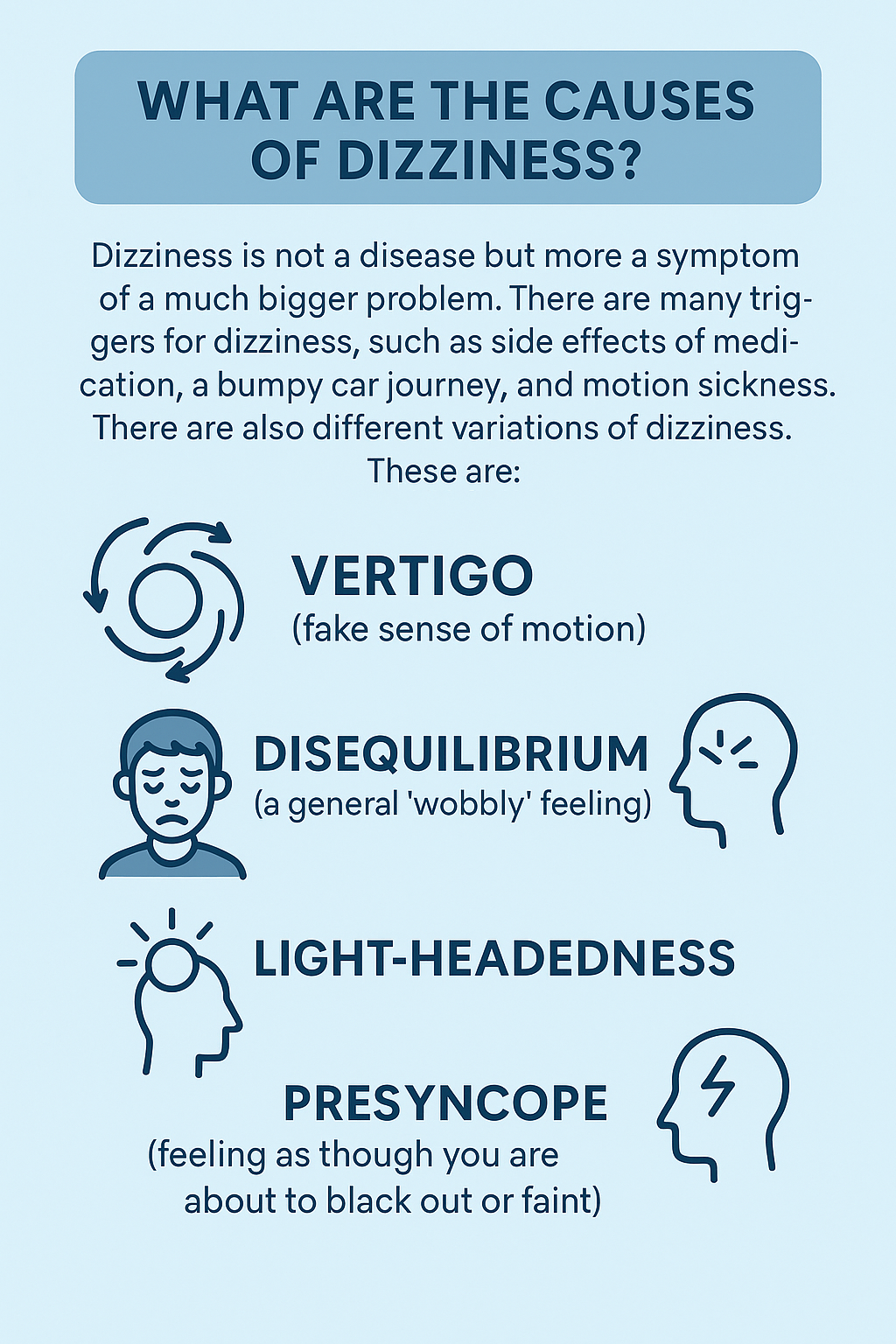
Head of Online Medical Content

Audiology Expert at Hearing Aid UK

Information About Dizziness, Hearing Loss
Looking into the body's balance system
What is dizziness? | Causes of dizziness | Dizziness and ringing in the ears | What is Meniere's disease? | Conclusion
Last Hearing Aid UK Update:
Overview
This article highlights the close connection between dizziness and hearing loss, often caused by shared structures in the inner ear. Conditions like Meniere’s disease, inner ear infections, or vestibular disorders may lead to both symptoms. It’s important to understand that dizziness isn’t just “feeling a bit woozy” – it can be a sign of a more complex balance-system issue, especially when linked with hearing problems.
It explains how the vestibular system controls balance and how its disruption can result in dizziness alongside hearing problems. The article also outlines common types of dizziness and stresses the need for medical evaluation. Early diagnosis of a vestibular problem can significantly improve quality of life: tailored therapies can reduce dizziness and help stabilise hearing.
Dizziness and hearing loss can coexist
Dizziness and hearing loss can coexist due to shared inner ear structures. Conditions like Meniere's disease or vestibular schwannoma may cause both symptoms. Inner ear infections or inflammation can also lead to temporary dizziness and hearing loss.
Prompt medical evaluation is vital to determine the underlying cause and appropriate treatment.
As well as looking into the reasons, causes, and treatments, we will be focusing on the inner ear, hearing loss, and dizziness in this article.
Hearing loss and dizziness are linked
Hearing loss and dizziness often go hand in hand, indicating potential underlying health issues. Hearing loss refers to a reduced ability to perceive sounds, either partially or completely. It can stem from various causes, such as ageing, exposure to loud noises, infections, or genetic factors.
Dizziness and hearing loss are two separate medical conditions, but they can sometimes be related. It’s not uncommon for people to dismiss the dizziness as unrelated, even though both symptoms may arise from the same inner-ear problem.
Dizziness is a common symptom of hearing loss, especially in people with severe or profound hearing loss. It can also be a side effect of certain medications used to treat hearing loss.
Dizziness is common
Dizziness is a common reason people see their GP. If you are feeling dizzy, it is important that you seek medical help quickly to be evaluated.
Dizziness can be due to various conditions and illnesses, but it is usually caused when the connection between the eyes, inner ear, and the brain is damaged.
What is dizziness?
Although dizziness can take many forms, it is always present when there is a disturbance to your sense of balance. It can be caused by a number of factors, including inner ear disorders, vestibular disorders, cardiovascular problems, and certain medications.
The symptoms of dizziness can be unsteadiness, disorientation, spinning, nausea, and feeling light-headed. But how and why does this happen?
Inside your ears, there are three small semi-circular canals containing both fluid and crystals, known as endolymph and otoliths. These crystals move and float in the fluid, mirroring your body's angular position.
There are two other semi-circular structures called the utricle and saccule, which recognise horizontal and vertical movements of your body.
Combined, your balance organ assists your body in understanding when you are going up, down, left, right, forward, and backwards, as well as touch and sight.
Your balance organ synchronises with your muscles, joints, and eyesight to give you a sense of balance and orientation within your surroundings. This is called the vestibular system.
This system relies on the maze of tissue and bone in the inner ear, which is where the cochlea and hearing nerve are located.
What are the causes of dizziness?
Dizziness is not a disease but more a symptom of a much bigger problem. There are many triggers for dizziness, such as side effects of medication, a bumpy car journey, and motion sickness. There are also different variations of dizziness. These are:
- Vertigo (a fake sense of motion).
- Disequilibrium (a general 'wobbly' feeling).
- Light-headedness.
- Presyncope (feeling as though you are about to black out or faint).

Dizziness and hearing loss in one ear
Inner ear dizziness is common, as dizziness is generally caused by a problem with your inner ear, problematic blood circulation, or pressure of fluid or nerves in the inner ear. For example, after a cold, your ears can become inflamed or swollen. This can result in bouts of dizziness.
Dizziness and ringing in the ears
Vertigo, tinnitus, and hearing loss are suggestive of long periods of dizziness. Various disorders affect the inner ears, which can result in tinnitus (or ringing of the ears) as well as dizziness. This could also be Meniere's disease and, in some rare cases, acoustic neuromas.
This can feel like a spinning sensation, commonly known as vertigo, together with light-headedness, which may persist or come and go. It may feel stronger when your head moves or when there are sudden movements in your body.
There may also be nausea; however, benign paroxysmal positional vertigo (or BPPV) has no other symptoms other than dizziness.

Is Hearing Loss and Dizziness Related?
What does dizziness and hearing loss mean?
What can cause dizziness and hearing loss?
What are the causes of dizziness and hearing loss? Balance and hearing are linked, as they share a pathway to the brain, and this is why there are many medical conditions that contribute to the causes of dizziness and hearing loss.
Such as severe allergic reactions, side effects of medication, circulatory conditions, and viral and bacterial infections of the inner ear.
Your ears oversee more than just hearing - they hold your vestibular system. This is why hearing loss affects your ability to hear and understand speech, but it can also affect your balance and cause balance disorders.
If you are experiencing hearing loss combined with any of these symptoms, you must seek medical help from your GP. If, when evaluated, you need hearing support, they will refer you to an audiologist for a full hearing test and future solutions.
What is Meniere's disease?
Sometimes, hearing loss and balance or dizziness aren't connected, and you might have Meniere's disease. This is an ear condition that affects the vestibular system and the inner ear. The inner ear and the Corti (part of the cochlea) fill with fluid and become swollen.
This then leads to dizziness, hearing loss, and a feeling of fullness in your ear. The symptoms, like hearing loss, can range from mild to severe.
Summary
If you are experiencing dizziness and hearing loss, it is important to consult with a healthcare professional first to determine the cause and appropriate treatment.
An audiologist can support you in diagnosing the cause of your hearing loss and provide effective solutions to help you feel and hear better again.
Maintaining good hearing health will improve your overall mental health and well-being in the future. In some cases, treating the underlying cause of the dizziness, such as an inner ear disorder or hearing loss, can also improve the dizziness.
In other cases, treatment may include medications or balance therapy to manage the dizziness.
It is also important to protect your hearing and avoid loud noises whenever possible, as hearing loss can lead to dizziness and other balance issues.
Wearing earplugs or earmuffs when exposed to loud noises and avoiding listening to music or other sounds at high volumes can help prevent hearing loss and the associated dizziness.
Why Choose Us?
- FREE Hearing Tests
- Best Hearing Aids and Prices
- FREE Aftercare for Life
- FREE Home Visits
- 200+ Local Audiologists
- 60 Day Money Back Guarantee
Need more support with dizziness and/or hearing loss?
If you are experiencing dizziness and hearing loss, your first point of call is your local GP who will look at your symptoms and diagnose any hearing loss that needs to be treated.
We advise that you regularly visit an audiologist even if it is just to check if your hearing has not deteriorated, which can often lead to temporary dizziness and vertigo.
If you think you might have hearing loss or your hearing has worsened and need some impartial advice on hearing healthcare and hearing aids - please call us free on 0800 567 7621
Other hearing loss awareness articles you might like...
 Tips for hearing in restaurants
Tips for hearing in restaurants  The impact of hearing loss and relationships
The impact of hearing loss and relationships  Hearing Loss and Mental Health
Hearing Loss and Mental Health Our specialist service includes:
Do not spend hundreds of pounds without getting a second opinion from us.
Please call us on 0800 567 7621
 Not only are the prices great, but the service is fantastic! Many thanks to your team.
Not only are the prices great, but the service is fantastic! Many thanks to your team.What's included in our hearing aid prices?
Other pages you might find useful
Common FAQs when researching hearing aids and hearing loss
In general, any audiologist will always recommend to you the hearing aid model that best suits your needs. Here is a useful checklist to make sure that is the case.
- Audiologist's level of knowledge: The audiologist you have seen will hopefully have a wide knowledge of all available hearing aids; however, some will only be familiar with a small number of brands and, therefore, may not really be in a position to know which model is the best for you. It is OK to challenge their recommendation and ask them to justify why this particular brand is the one for you.
- Do research: Read about the hearing aid that was recommended. Does it seem like it will suit your lifestyle? Does it have more or fewer features than you need?
- Be aware of sales targets: Many high street retailers have specific tie-ins to a particular manufacturer/brand. The hearing aid they have suggested may still be the correct one for you, but do your research so that you know why they might have recommended it.
If you have significant hearing loss in both ears, you should be wearing two hearing aids. Here are the audiological reasons why:
Localisation: The brain decodes information from both ears and compares and contrasts them. By analysing the minuscule time delays as well as the difference in the loudness of each sound reaching the ears, the person is able to accurately locate a sound source.
Simply put, if you have better hearing on one side than the other, you can't accurately tell what direction sounds are coming from.
Less amplification is required: A phenomenon known as “binaural summation” means that the hearing aids can be set at a lower and more natural volume setting than if you wore only one hearing aid.
Head shadow effect: High frequencies, the part of your hearing that gives clarity and meaning to speech sounds, cannot bend around your head. Only low frequencies can. Therefore, if someone is talking on your unaided side, you are likely to hear that they are speaking, but be unable to tell what they have said.
Noise reduction: The brain has its own built-in noise reduction, which is only really effective when it is receiving information from both ears. If only one ear is aided, even with the best hearing aid in the world, it will be difficult for you to hear in background noise as your brain is trying to retain all of the sounds (including background noise) rather than filtering them out.
Sound quality: We are designed to hear in stereo. Only hearing from one side sounds a lot less natural to us.
Fancy some further reading on this topic? You can read about why two hearing aids are better than one in our article, hearing aids for Both Ears, here
For most people, the main benefit of a rechargeable hearing aid is simple convenience. We are used to plugging in our phones and other devices overnight for them to charge up. Here are some other pros and cons:
For anybody with poor dexterity or issues with their fingers, having a rechargeable aid makes a huge difference, as normal hearing aid batteries are quite small and some people find them fiddly to change.
One downside is that if you forget to charge your hearing aid, then it is a problem that can't be instantly fixed. For most, a 30-minute charge will get you at least two or three hours of hearing, but if you are the type of person who is likely to forget to plug them in regularly, then you're probably better off with standard batteries.
Rechargeable aids are also a little bit bigger and are only available in Behind-the-Ear models.
Finally, just like with a mobile phone, the amount of charge you get on day one is not going to be the same as you get a few years down the line. Be sure to ask what the policy is with the manufacturer's warranty when it comes to replacing the battery.
For most people, the answer is yes. But it's never that simple.
The majority of hearing problems affect the high frequencies a lot more than the low ones. Therefore, open fitting hearing aids sound a lot more natural and ones that block your ears up can make your own voice sound like you are talking with your head in a bucket. Therefore, in-ear aids tend to be less natural.
However, the true answer is we can't tell until we have had a look in your ears to assess the size of your ear canal, and until we have tested your hearing to see which frequencies are being affected.
People with wider ear canals tend to have more flexibility, also there are open fitting modular CIC hearing aids now that do not block your ears.
There is also the age-old rule to consider, that a hearing aid will not help you if it's sat in the drawer gathering dust. If the only hearing aid you would be happy wearing is one that people can't see, then that's what you should get.
Most people can adapt to any type of hearing aid, as long as they know what to expect. Have an honest conversation with your audiologist as to what your needs are.
Generally speaking, six or more. Unless it's none at all. The number of channels a hearing aid has is often a simplistic way an audiologist will use to explain why one hearing aid is better than another, but channels are complex, and it is really not that straightforward. Here are some reasons why:
Hearing aids amplify sounds of different frequencies by different amounts. Most people have lost more high frequencies than low, and therefore need more amplification in the high frequencies. The range of sounds you hear is split into frequency bands or channels, and the hearing aids are set to provide the right amount of hearing at each frequency level.
Less than six channels, and this cannot be done with much accuracy, so six is the magic number. However, a six-channel aid is typically very basic with few other features and is suitable only for hearing a single speaker in a quiet room. The number of channels is not what you should be looking at; it's more the rest of the technology that comes with them.
As a final note, different manufacturers have different approaches. One method is not necessarily better than any other. For example, some manufacturers have as many as 64 channels in their top aids. Most tend to have between 17 and 20. One manufacturer has no channels at all.
Manufacturer's warranties typically last between 2-5 years, depending on the brand and model, and cover defects in materials and workmanship. This includes repairs for component failures, electronic malfunctions, and manufacturing defects, but excludes damage from misuse, accidents, or normal wear. Most manufacturers also include loss and damage insurance for the first year.
We handle all warranty claims on your behalf, liaising with manufacturers and ensuring you get replacement devices quickly when needed. This comprehensive warranty coverage, combined with our lifetime aftercare, gives you complete peace of mind.
Our hearing tests are completely free, whether at our clinics or in your home. Unlike other providers who charge £30-£100 for home visits, we believe hearing healthcare should be accessible without financial barriers. Our comprehensive assessments include examination by a registered audiologist, audiogram results, and personalised recommendations.
All testing, future adjustments, and ongoing support are included at no extra cost. While NHS tests are also free, typical 6-week waiting periods often lead people to seek immediate private testing. We provide prompt, professional assessments that fit your schedule and budget.
Yes, we offer completely free home visits throughout the UK, and this service is included in our prices with no additional charges. Home visits are particularly valuable for people with mobility issues, busy schedules, or those who simply prefer the comfort and convenience of their own environment.
Our audiologists can conduct full hearing tests, fit hearing aids, and provide ongoing support in your home. This service sets us apart from many providers who either don't offer home visits or charge extra for them.
We can offer prices up to 40% lower than high street retailers because of our business model. As a network of 200+ independent audiologists, we don't have the massive overheads of large retail chains - no expensive high street premises, no sales targets pushing audiologists to sell the most expensive options, and no costly marketing campaigns.
However, we maintain the same buying power as the big chains because we purchase on behalf of our entire nationwide network. This means you get access to the same premium hearing aids with professional service, but at genuinely competitive prices.
We offer a comprehensive 60-day money-back guarantee, which gives you twice the industry standard time to properly assess whether your hearing aids are right for you. This extended period recognises that adjusting to hearing aids takes time, and your brain needs several weeks to adapt to the amplified sounds.
Unlike many providers who offer just 30 days, we believe 60 days gives you the confidence to test your hearing aids in all the situations that matter to you - from quiet conversations at home to busy restaurants and outdoor activities.
Ask the Experts
6 Morton Lane
Walkwood
Redditch
Worcestershire
B97 5QA
Latest Launch
When we refer to a product as 'Latest Launch', we mean it is the latest to be released on the market.
New
When we refer to a product as 'New', we mean that the product is the newest hearing aid model on the market.
When we refer to a product as 'Superseded', we mean that there is a newer range available which replaces and improves on this product.
Older Model
When we refer to a product as an 'Older Model', we mean that it is has been superseded by at least two more recent hearing aid ranges.
